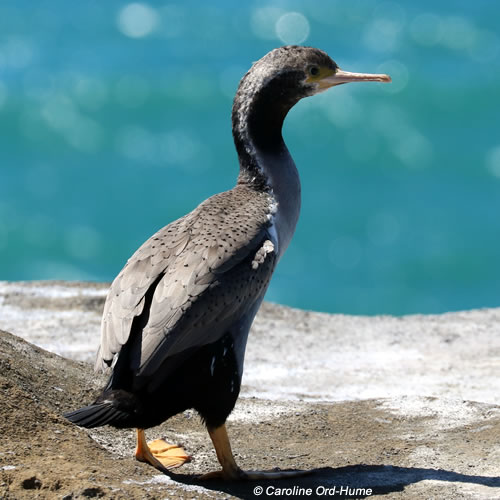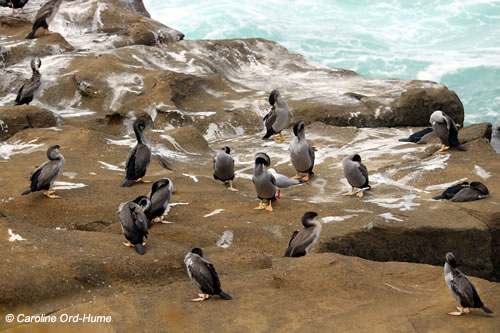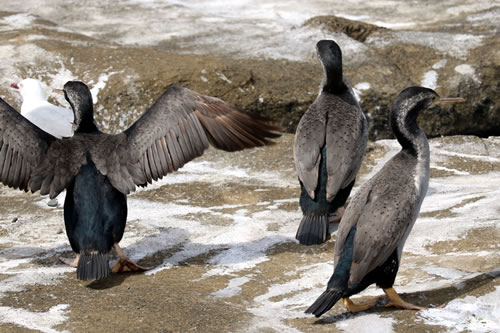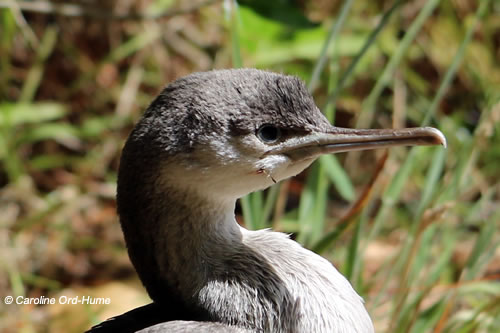Spotted Shag - Cormorant
Spotted Shags, Parekareka, are endemic to New Zealand and have a conservation status of not being under threat.
Find out about these beautiful and distinctive shags with spots on their feathers, where they roost and feed, and how to identify them.
Adult Spotted Shag Species Identification. Spots on Feathers, Stripe Neck, Yellow Feet, Eye and Face Skin Colouring. Porpoise Bay Headland, Catlins, South Island, New Zealand

Spotted Shag (Stictocarbo punctatus) Family: Phalacrocoracidae
The various names this species of shag are known by extends to Spotted Shag, Spotted Cormorant, Parekareka, Kawau Tikitiki, and Blue Shag S.p. oliveri. The Blue Shag is a southern subspecies that inhabits Stewart Island and the West Coast of the South Island but distinction of this subspecies has been questioned.
The naming of Spotted Shag species is due to black spots appearing in breeding season near tips of feathers on their backs and wings making them distinctive from other species.
Habitat and Distribution
Spotted shags are completely marine birds that breed on the coasts of the North Island, South Island, and Stewart Islands, with their feeding grounds extending up to 16km from the coast, sometimes choosing to feed and roost in estuaries and inlets.
Colony of Spotted Shags Preening. Juvenile and Adult Birds on Headland Cliffs Between Porpoise Bay and Curio Bay

You can see extremely large flocks of Spotted Shags outside of the breeding season in the New Zealand winter, up to two thousand birds in a colony.
Spotted Shag Description and Identification
These are thoroughly beautiful and distinctive birds.
3 Spotted Shags Displaying Colours for Species Identification

Adult Spotted Shags plumage is colourful during breeding not only with the spots on their back and wing feathers, but also with a double crest, green blue facial skin, and stunning blue eye rings.
Spotted Shags and Pitt Island Shags are the only shag species with yellow feet that are endemic to New Zealand.
The species is of a medium size, slim, grey colour, with a slender orange brown hooked bill.
A white stripe runs own the sides of their long slender neck.
Juvenile Spotted Shags are pale in colour compared to adult breeding shags, with head and neck markings also being less distinctive.
Diet
The can dive into deep water offshore and their diet consists of small fish, marine invertebrates, squid, and plankton.
Conservation
New Zealand Spotted Shags are not considered to be under threat as there is an estimated total population of between 10,000 and 50,000 breeding pairs… that’s quite a wide estimation figure!
Shags can sometimes be caught accidentally in fishing tackle or nets. They can also be injured by fishing hooks and gear.
Immature Spotted Shag with Neck, Body, and Leg Injuries from a Dog Attack. Christchurch, South Island, New Zealand

Shags do not appear to be a very nervous bird when approached, and find it hard to fly away with wet feathers; therefore they are also vulnerable to attack by loose dogs.
I discovered a juvenile Spotted Shag wandering around a campsite that looked disoriented and was limping. It was found to be suffering from a dog attack, with bite marks on the side of its head and body and some damage to its leg. I reported it to DOC and it was collected by a ranger. See image of injured shag bird above.
Also see... list of species of New Zealand shags / cormorants.
More about wildlife in NZ...
List of native New Zealand bird species and a list of wild animals in and around New Zealand